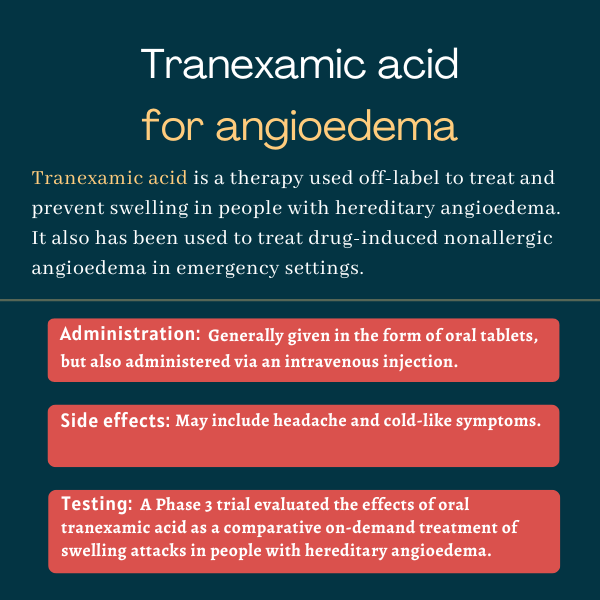
Tranexamic acid for angioedema
Last updated Jan. 30, 2025, by Marisa Wexler, MS

What is tranexamic acid for angioedema?
Tranexamic acid is a medication approved for certain bleeding conditions. It is considered an antifibrinolytic agent that works to prevent blood clots from breaking down too quickly, thereby keeping bleeding under control.
Although tranexamic acid is not formally approved to treat any type of angioedema, it has been used off-label to prevent or treat swelling attacks in people with hereditary angioedema (HAE). While tranexamic acid may have some efficacy for HAE, it’s generally considered to be much less effective than other approved medications, so it is usually only given as a first-line treatment if other therapies aren’t available.
Tranexamic acid has also been used off-label for other types of angioedema, including drug-induced nonallergic angioedema, in emergency situations.
Brand names and formulations
In the U.S., an oral tablet form of tranexamic acid was sold by Ferring Pharmaceuticals under the brand name Lysteda. This tablet, which was approved to treat heavy menstrual bleeding, is the main formulation used for angioedema. Although the brand-name medicine was discontinued, several generic versions of this oral formulation are available.
Tranexamic acid can also be administered via an into-the-vein (intravenous) injection. This formulation, which is approved for hemophilia, is sold by Pfizer under the brand name Cyklokapron. Generic versions of the injectable formulation of tranexamic acid are also available.
Therapy snapshot
| Treatment name: | Tranexamic acid |
| Administration: | Oral tablets and intravenous injection |
| Clinical testing: | A Phase 3 trial evaluated the effects of oral tranexamic acid in people with hereditary angioedema |
How does tranexamic acid work in angioedema?
In HAE and some other types of angioedema, too much of a signaling molecule called bradykinin is produced and excessive levels are thought to lead to swelling attacks. Bradykinin normally causes blood vessels to become wider and more permeable, enabling fluids to leak out and pool in nearby tissues, resulting in swelling.
Bradykinin production in the body is linked to the activity of an enzyme called plasmin, which in turn is derived from a protein called plasminogen. Tranexamic acid works by stopping plasminogen activation and inhibiting plasmin formation and activity, ultimately lowering the levels of bradykinin in the body, which is expected to reduce swelling.
How is tranexamic acid administered in angioedema?
An oral formulation of tranexamic acid, formerly sold under the brand name Lysteda and also available as generics, is generally the one used to treat angioedema. This formulation is given as oral tablets containing 650 mg of the therapy’s active ingredient.
Because tranexamic acid is not approved for angioedema, there is no standardized dosing regimen for its use in people with the condition. However, according to guidelines from the U.S. HAE Association, when used as a prophylactic or preventive treatment for HAE attacks, tranexamic acid should be given at an average dose of 1 g twice daily (0.25 g twice daily to 1.5 g three times daily) in adults, and at an average dose of 20 mg/kg twice daily (10 mg/kg twice daily to 25 mg/kg three times daily) in children.
Tranexamic acid in angioedema clinical trials
Some clinical trials, case reports, and other studies describe the use of tranexamic acid in patients with different types of angioedema.
Studies in HAE
The only clinical trial to formally evaluate tranexamic acid in people with HAE was a Phase 3 clinical trial called FAST2 (NCT00500656). In the study, 74 people with HAE were randomly assigned to on-demand treatment with oral tranexamic acid, at 3 g daily for two days, or with Firazyr (icatibant), given as a single 30 mg dose via under-the-skin injection, when they experienced a swelling episode.
FAST2’s main goal was to compare how long it took for each treatment to provide clinically meaningful relief from swelling symptoms. Trial results showed the median time to symptom relief was two hours for patients given Firazyr and 12 hours for those given tranexamic acid, indicating the superiority of Firazyr over tranexamic acid as an on-demand treatment for HAE.
The low efficacy of tranexamic acid as an on-demand treatment for HAE compared with other therapies was also reported in several observational studies.
Although the use of tranexamic acid as a prophylactic treatment for HAE has not been evaluated formally in a randomized clinical trial, several case reports, case series studies, and observational studies have reported benefits associated with its use. For instance, an observational study involving 104 HAE patients reported tranexamic acid lowered the frequency of attacks in 70% of the patients, while a case series study showed tranexamic acid eliminated or significantly reduced the frequency or severity of swelling attacks in 12 of the 16 HAE patients who participated.
Studies in other types of angioedema
Several studies evaluated the use of tranexamic acid as an on-demand treatment in an emergency setting for angioedema that occurs as a side effect of angiotensin-converting enzyme inhibitors (ACEIs), a type of blood pressure medication.
In one of these studies, a total of 16 patients were treated with tranexamic acid that was given intravenously in the emergency department for suspected ACEI-induced angioedema. Results showed that following the administration of tranexamic acid, more than 85% of the patients saw their symptoms partly or fully resolve, with three people requiring admission to the intensive care unit for higher level care. A review of published studies also suggested tranexamic acid may be especially helpful to ease symptoms and prevent intubation in patients with ACEI-induced angioedema in an emergency.

Common side effects of tranexamic acid
The specific safety profile of tranexamic acid in people with angioedema is not fully known, but headache and cold-like symptoms have been reported in HAE patients given the medication in a Phase 3 clinical trial.
The most common side effects associated with oral formulations of tranexamic acid include:
- headache or migraine
- pain in the back, abdomen, joints and/or muscles
- muscle cramps
- cold-like symptoms
- anemia
- fatigue.
Blood clotting complications
Blood clotting-related complications have been reported in patients given oral tranexamic acid.
In women using hormonal contraceptives (birth control pills), tranexamic acid may increase the risk of serious blood clotting problems. For this reason, tablets of tranexamic acid are contraindicated, or not recommended, for women with reproductive potential who are taking hormonal contraceptives or are known to have certain medical conditions that increase their risk of experiencing blood clotting-related complications.
Due to the risk of blood clotting issues, tranexamic acid is also not recommended for patients taking factor IX complex concentrates or anti-inhibitor coagulant concentrates. Likewise, tranexamic acid is not recommended for patients who have a type of blood cancer called acute promyelocytic leukemia and are taking all-trans retinoic acid, as that may enhance its procoagulant properties.
Allergic reactions
Rare cases of severe allergic reactions have been reported in patients treated with tranexamic acid. If a serious allergy occurs, the treatment should be stopped immediately and appropriate supportive care be given at once. Tranexamic acid tablets are contraindicated for women of reproductive potential who are known to be allergic to the medication.
Eye problems and brain bleeding
Problems with the eyes and vision issues have been reported in patients taking tranexamic acid tablets. Patients who experience eye problems should stop taking tranexamic acid immediately and be referred for evaluation by an eye specialist.
In patients with subarachnoid hemorrhage, a type of bleeding occurring in the space surrounding the brain, the use of tranexamic acid may cause swelling and disrupt blood flow in the brain.
Use in pregnancy and breastfeeding
Tranexamic acid has not been rigorously studied in women who are pregnant or breastfeeding. It is known that the therapy can cross the placenta to a developing fetus, and that small amounts of it can pass into breastmilk. In animal studies, the use of tranexamic acid during pregnancy didn’t cause any notable issues. The therapy’s potential effects on a breastfed infant or on milk production are unknown.
Nevertheless, tranexamic acid is not approved for use by pregnant women. Decisions on whether to use tranexamic acid during breastfeeding should be discussed with healthcare professionals and made by carefully weighing its potential risks and benefits.
Angioedema News is strictly a news and information website about the disease. It does not provide medical advice, diagnosis, or treatment. This content is not intended to be a substitute for professional medical advice, diagnosis, or treatment. Always seek the advice of your physician or other qualified health provider with any questions you may have regarding a medical condition. Never disregard professional medical advice or delay in seeking it because of something you have read on this website.
Recent Posts
- 1 lonvo-z dose keeps most HAE patients attack-free up to 3 years
- For many of us, becoming a patient advocate wasn’t optional
- FDA extends Orladeyo approval to children as young as 2
- With chronic illness, we can’t brush off holiday stress so easily
- Abrupt danazol stop in HAE can cause temporary hepatitis: Study



